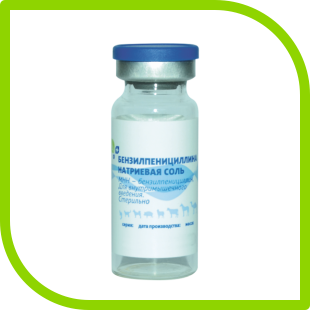
INSTRUCTIONS
of using benzylpenicillin sodium for veterinary medicine
(Production organization: BioKhimPharm, Vladimir Region, Raduzhny)
I. General information
1. Benzylpenicillin sodium salt (Benzylpenicillinum-natrium).
2. As an active substance, the drug contains benzylpenicillin.
3. The preparation is a crystalline powder from white to light yellow. It is readily soluble in water and 0.9% isotonic sodium chloride solution.
4. The preparation is packed in glass bottles of 1000000ED each.
5. Store with caution (List B) in a dry, dark place at a temperature of 5 ° C to 25 ° C.
Shelf life of the drug is 3 years from the date of manufacture, subject to storage conditions.
II. Pharmacological properties
6. Benzylpenicillin sodium salt has a bactericidal effect against gram-positive and gram-negative microorganisms: staphylococci, pneumococci, tetanus, anthrax, pig face, gas gangrene and others.
The drug is ineffective against most gram-negative bacteria, rickettsia, viruses, protozoa, fungi.
7. The mechanism of action of the drug is associated with a violation of the synthesis of acetylmuric acid – an integral part of the mucopeptide, which is necessary for the synthesis of the wall of the bacterial cell. With its deficiency, the ability of the microbial cell to assimilate amino acids and other vital substances is impaired.
8. Benzylpenicillin sodium salt is well absorbed during parenteral administration and stored in blood at therapeutic concentrations for about 3-4 hours. The drug is found in relatively high concentrations in the liver, kidneys, lungs, but it does not penetrate well into the myocardium, brain, bone tissue, synovial fluid. It is excreted unchanged in the main with urine, in part with bile, saliva, milk.
III. The order of application
9. Benzylpenicillin sodium salt is prescribed for diseases caused by susceptible to benzylpenicillin microorganisms, including necrobacteriosis, pasteurellosis, pneumonia, mastitis, endometritis, septicemia, phlegmon, wound infections, otitis, urinary tract infections, actinomycosis, pollen swine, erysipelas, spirochaetosis of birds, etc., as well as for viral diseases in case of complication with bacterial infection.
10. The drug is administered intramuscularly with an interval of 6 hours in the following single doses, based on thousands of units per kg of body weight:
|
Animal species |
Single dose (thousand units) |
|
|
adults |
young |
|
|
Cattle |
3 |
5 |
|
Horses |
2 |
3 |
|
Small cattle |
4 |
10 |
|
Pigs |
6 |
8 |
|
Fur animals, dogs |
20 |
30 |
|
Birds |
30 |
50 |
The first dose should be doubled.
The course of treatment is not less than 4-7 days, with severe forms of the disease 7-10 days or more.
The sodium salt of benzylpenicillin can be administered intravenously. In this case, the dose of the drug should be reduced by half as compared with the intramuscular route of administration.
11. Adverse events and complications. With intramuscular injection of the drug, there are sometimes rapidly developing allergic reactions (up to anaphylactic shock). In this case, animals are administered antihistamines and a calcium chloride preparation.
12. The drug is contraindicated
13. Passage of the next dose of the drug should be avoided, as this may lead to a decrease in therapeutic effectiveness. In the case of missing one dose, the drug is resumed in the same dosage and according to the same schedule.
14. With the introduction of benzylpenicillin sodium salt in animals, rapidly developing allergic reactions (urticaria, diarrhea, angioedema, anaphylactic shock) are sometimes manifested. In the case of allergic reactions, animals are administered in commonly used doses of diphenhydramine, calcium chloride, vitamin B1, adrenaline.
15. Penicillins can not be mixed in one syringe or in one infusion system with aminoglycosides because of their physico-chemical incompatibility. Bactericidal antibiotics (including cephalosporins, vancomycin, rifampicin, aminoglycosides) have a synergistic effect; bacteriostatic (including macrolides, chloramphenicol, lincosamides, tetracyclines) – antagonistic. Increases the effectiveness of indirect anticoagulants (suppressing the intestinal microflora, reduces the prothrombin index). Diuretics, allopurinol, tubular secretion blockers, phenylbutazone, NSAIDs, reducing tubular secretion, increase the concentration of benzylpenicillin. Allopurinol increases the risk of allergic reactions (skin rashes).
16. Slaughter animals for meat is allowed no earlier than 3 days after the last use of the drug. The meat of animals that were forced to die before the expiration of this period may be used for feeding carnivores or for the production of meat and bone meal.
Milk, obtained from animals during the treatment with benzylpenicillin sodium salt and before the expiration of 24 hours after the last administration of the antibiotic, is prohibited for use for food purposes. Such milk is used for feeding animals.
IV. Personal prevention measures
17. When working with benzylpenicillin sodium salt, you should observe the general rules of personal hygiene and safety, provided for when working with medicines.
18. Do not drink, smoke or eat while working with a medicine. After working with Benzylpenicillin, sodium salt should be washed with soap and water.
19. In case of accidental ingestion of the drug on the skin or mucous membranes, it must be washed off immediately with running water and soap. In case of allergic reactions, you should immediately contact a medical institution (with you to have instructions for the use of the drug or a label).





